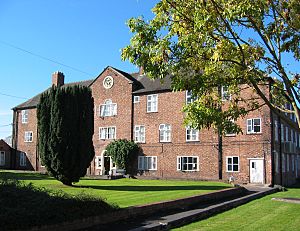Workhouse facts for kids
A workhouse was a place that gave housing and work to people who had nowhere else to go. They first started in England and Wales in the 17th century. The word "workhouse" was first used in a report in 1631. This report was about building a workhouse in the town of Abingdon.
Workhouses came about because of old laws. One early law was the Poor Law Act of 1388. This law tried to help with a shortage of workers after the Black Death. It made it hard for people to move around. It also stopped them from finding better-paying jobs. This meant the government became responsible for helping poor people.
Later, after the Napoleonic Wars, many people lost their jobs. Machines also took over work from farm workers. This caused more unemployment. In the 1830s, there were also several bad harvests. All these problems made it very hard to help everyone who was poor.
Contents
New Laws for the Poor
New laws were made to deal with poverty. The New Poor Law of 1834 was one of these. It said that people would only get help if they lived in a workhouse. Some places hoped to make money from workhouses. They would use the free labor of the people living there.
Workhouse Jobs
Most people in workhouses did not have special skills. So, the jobs were often very basic. These jobs included breaking rocks into small stones. People also broke bones to make fertilizer. Another common job was pulling apart old rope. This old rope was called oakum. It was used to make ships watertight. Workers used a metal spike to unpick the rope. Because of this spike, the workhouse was often called the spike.
Life Inside a Workhouse
Life in a workhouse was meant to be very hard. This was so only the very poorest people would go there. The idea was that people would only seek help if they had no other choice. However, workhouses did offer some good things. They provided free medical care. Children living there also received an education. Poor people outside the workhouse usually did not get this kind of help.
Workhouses Change Over Time
By the late 1800s, workhouses started to change. They became filled more with old and sick people. Fewer unemployed people went there. In 1929, the laws changed again. Many workhouses became hospitals. Some were renamed Public Assistance Institutions. Workhouses finally disappeared in 1948. This happened when the National Assistance Act was passed.
Images for kids
-
The 'Red House' at Framlingham Castle in Suffolk was founded as a workhouse in 1664.
-
Ripon Union Workhouse, completed in 1855, replaced an earlier Georgian era workhouse. It now houses a museum.
-
Thomas Allom's design for St Mary Abbots workhouse in Kensington, London, is noticeably different from those produced by Sampson Kempthorne a decade earlier.
See also
 In Spanish: Workhouse para niños
In Spanish: Workhouse para niños












